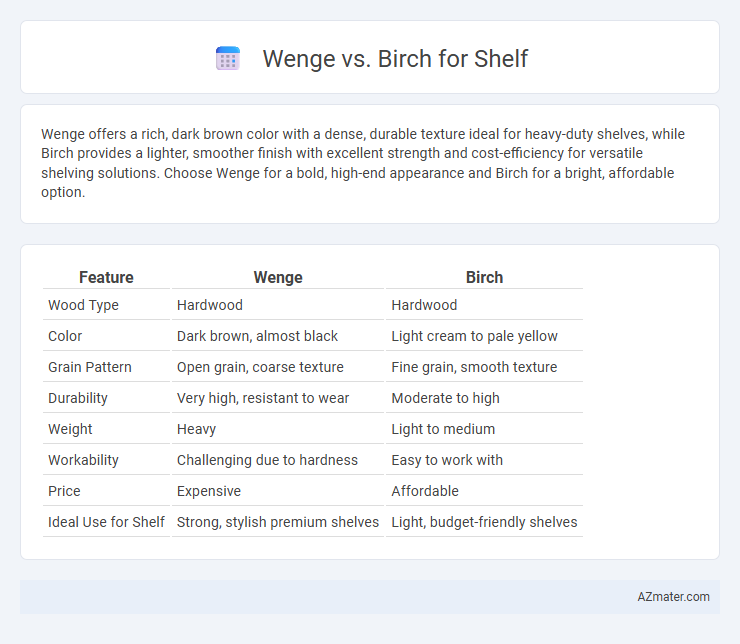Wenge offers a rich, dark brown color with a dense, durable texture ideal for heavy-duty shelves, while Birch provides a lighter, smoother finish with excellent strength and cost-efficiency for versatile shelving solutions. Choose Wenge for a bold, high-end appearance and Birch for a bright, affordable option.
Table of Comparison
| Feature | Wenge | Birch |
|---|---|---|
| Wood Type | Hardwood | Hardwood |
| Color | Dark brown, almost black | Light cream to pale yellow |
| Grain Pattern | Open grain, coarse texture | Fine grain, smooth texture |
| Durability | Very high, resistant to wear | Moderate to high |
| Weight | Heavy | Light to medium |
| Workability | Challenging due to hardness | Easy to work with |
| Price | Expensive | Affordable |
| Ideal Use for Shelf | Strong, stylish premium shelves | Light, budget-friendly shelves |
Introduction: Wenge vs Birch for Shelf Selection
Wenge wood offers a deep, rich brown color with distinctive grain patterns, providing a luxurious and robust aesthetic for shelving. Birch wood is lighter in tone, typically pale cream to yellow, known for its smooth texture and strong durability, making it ideal for versatile and modern shelving designs. Choosing between Wenge and Birch hinges on desired visual appeal and the shelf's functional role in a space.
Wood Characteristics: Wenge and Birch Compared
Wenge wood features a rich, dark brown color with striking black grain patterns, known for its high density and exceptional hardness, making it highly durable and resistant to wear, ideal for heavy-use shelves. Birch wood presents a lighter, creamy white or pale yellow hue with a fine, even texture, valued for its strength and smooth finish, which allows for easy staining and a variety of design styles. While Wenge offers a more exotic and robust aesthetic, Birch provides versatility and affordability, making these woods distinct choices depending on shelf durability and visual appeal requirements.
Durability and Strength: Wenge vs Birch
Wenge wood offers exceptional durability and strength, with a Janka hardness rating of approximately 1630, making it highly resistant to dents and wear for long-lasting shelves. Birch, with a Janka hardness around 1260, provides good durability but is softer and more prone to scratches compared to Wenge. For shelves requiring maximum load-bearing capacity and longevity, Wenge is the superior choice due to its dense, hard-wearing nature.
Aesthetic Appeal: Color and Grain Differences
Wenge wood offers a deep, rich chocolate-brown color with fine, straight grains creating a bold, sophisticated look for shelves, while birch showcases a lighter, creamy-yellow tone with smooth, subtle grain patterns that impart a clean and modern aesthetic. The dark hue and pronounced texture of wenge add dramatic contrast, ideal for statement pieces, whereas birch's uniform lightness fits seamlessly into minimalist or Scandinavian-inspired interiors. Choosing between wenge and birch for shelving depends on the desired visual impact and room ambiance, balancing the richness of wenge against the airy brightness of birch.
Workability: Ease of Cutting and Shaping
Wenge wood is dense and hard, making it more challenging to cut and shape but providing excellent durability for shelves. Birch is a softer hardwood that offers superior workability with smoother cutting and easier shaping using standard woodworking tools. Choosing birch simplifies construction and finishing processes, while wenge requires more precision and sharper tools to avoid splintering.
Cost Analysis: Wenge vs Birch Pricing
Wenge wood typically commands a higher price than birch due to its exotic origin, rich dark grain, and limited availability, making it a premium choice for shelving. Birch is more affordable, widely available, and offers a lighter, uniform texture, providing excellent cost efficiency without compromising durability. When budgeting for shelving projects, selecting birch yields significant savings, while wenge offers a luxurious aesthetic at a higher investment.
Weight and Load-Bearing Capacity
Wenge wood is significantly denser and heavier than birch, with a typical weight around 700-800 kg/m3 compared to birch's 600-650 kg/m3, offering superior load-bearing capacity for shelves. The higher density of wenge translates to enhanced strength and durability, making it ideal for supporting heavy items without warping or sagging. Birch, while lighter and easier to handle, provides moderate load support but may require additional reinforcement for heavy-duty shelving applications.
Environmental Sustainability and Sourcing
Wenge wood, sourced primarily from Central African rainforests, is known for its durability but faces sustainability concerns due to overharvesting and slow growth rates, leading to stricter regulations and limited availability. Birch, harvested mainly from North American and European forests, offers a more sustainable option with faster growth cycles and responsible forestry practices promoting reforestation and reduced environmental impact. Choosing birch for shelving supports better forest management and aligns with eco-friendly sourcing standards compared to the more environmentally sensitive wenge.
Maintenance and Longevity
Wenge wood offers exceptional durability and resistance to wear, making it ideal for long-lasting shelves with minimal maintenance, as its dense grain naturally repels scratches and moisture. Birch, while less dense than wenge, requires regular sealing and careful cleaning to prevent warping and staining, thus demanding more maintenance for shelf longevity. Choosing wenge ensures a robust shelf that withstands heavy use over time, whereas birch shelves need consistent upkeep to maintain their structural integrity and appearance.
Best Applications: Choosing Between Wenge and Birch for Shelves
Wenge wood offers exceptional durability and a rich, dark finish ideal for modern or high-contrast shelves in living spaces and offices, showcasing strength and resistance to wear. Birch provides a lighter, smooth texture with excellent stability, making it perfect for shelves in kitchens or bedrooms where a bright, clean aesthetic is preferred. Selecting between Wenge and Birch depends on the desired visual impact and environment, with Wenge suited for heavy-duty use and bold designs, while Birch excels in subtle, versatile applications with moderate weight requirements.

Infographic: Wenge vs Birch for Shelf
 azmater.com
azmater.com